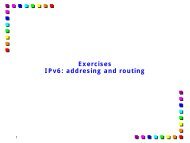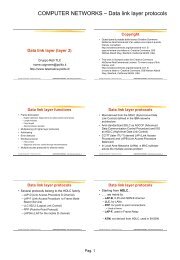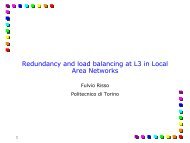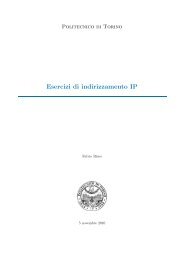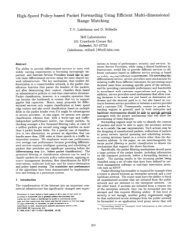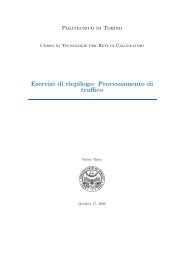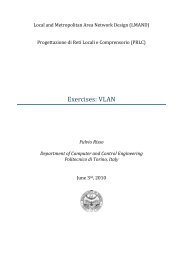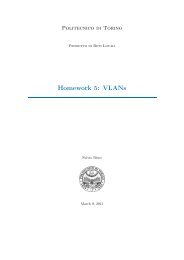Esercizi Routing.pdf - the Netgroup at Politecnico di Torino
Esercizi Routing.pdf - the Netgroup at Politecnico di Torino
Esercizi Routing.pdf - the Netgroup at Politecnico di Torino
You also want an ePaper? Increase the reach of your titles
YUMPU automatically turns print PDFs into web optimized ePapers that Google loves.
A questo punto, si può verificare il fenomeno del count to infinity, in cui R2 annuncierà la rete F a<br />
costo 5 verso R3 e così via, poi R3 la annuncierà a costo 6 verso R4, ...<br />
4.6.3. Guasto con hold-down<br />
Dall’istante in cui si verifica il guasto, uno dei possibili scenari sulla rete è:<br />
1. R2 rileva imme<strong>di</strong><strong>at</strong>amente il guasto (ma supponendo i triggered upd<strong>at</strong>es <strong>di</strong>sabilit<strong>at</strong>i, non invia<br />
comunque nessuna informazione in rete);<br />
2. Allo scadere dell’upd<strong>at</strong>e timer, R2 invia i suoi <strong>di</strong>stance vector, simili a quelli in caso <strong>di</strong> rete stabile,<br />
tranne per il f<strong>at</strong>to che la rete F non viene più annunci<strong>at</strong>a, poichè è <strong>di</strong>vent<strong>at</strong>a irraggiungibile (e<br />
si suppone <strong>di</strong>sabilit<strong>at</strong>o il route poisoning):<br />
DV(R2) su A<br />
Rete Costo<br />
B 1<br />
C 2<br />
G 2<br />
DV(R2) su B<br />
Rete Costo<br />
A 1<br />
D 2<br />
E 2<br />
H 3<br />
3. R3 non riceve più nessun annuncio della rete F (da ogni <strong>di</strong>rezione), ma continua ad annunciarla<br />
fino allo scadere del suo route invalid timer nel suo <strong>di</strong>stance vector verso R4:<br />
DV(R3) su C<br />
Rete Costo<br />
A 2<br />
B 1<br />
E 3<br />
F 2<br />
G 1<br />
4. R1 non riceve più l’annuncio della rete F da R2, ma continua a ricevere quello da R4 (a costo 3).<br />
Allo scadere del suo route invalid timer tuttavia, la precedente route viene <strong>di</strong>chiar<strong>at</strong>a irraggiungibile<br />
e questo sc<strong>at</strong>ena l’<strong>at</strong>tivarsi dell’hold-down timer, che blocca la route per 180 secon<strong>di</strong>; in<br />
questo intervallo <strong>di</strong> tempo, il suo <strong>di</strong>stance vector verso R2 non conterrà la rete F (a <strong>di</strong>fferenza<br />
del caso precedente, in cui l’assenza dell’hold-down permetteva al router <strong>di</strong> cambiare imme<strong>di</strong><strong>at</strong>amente<br />
la route):<br />
DV(R1) su A<br />
Rete Costo<br />
C 2<br />
D 1<br />
E 1<br />
H 2<br />
G 3<br />
32



